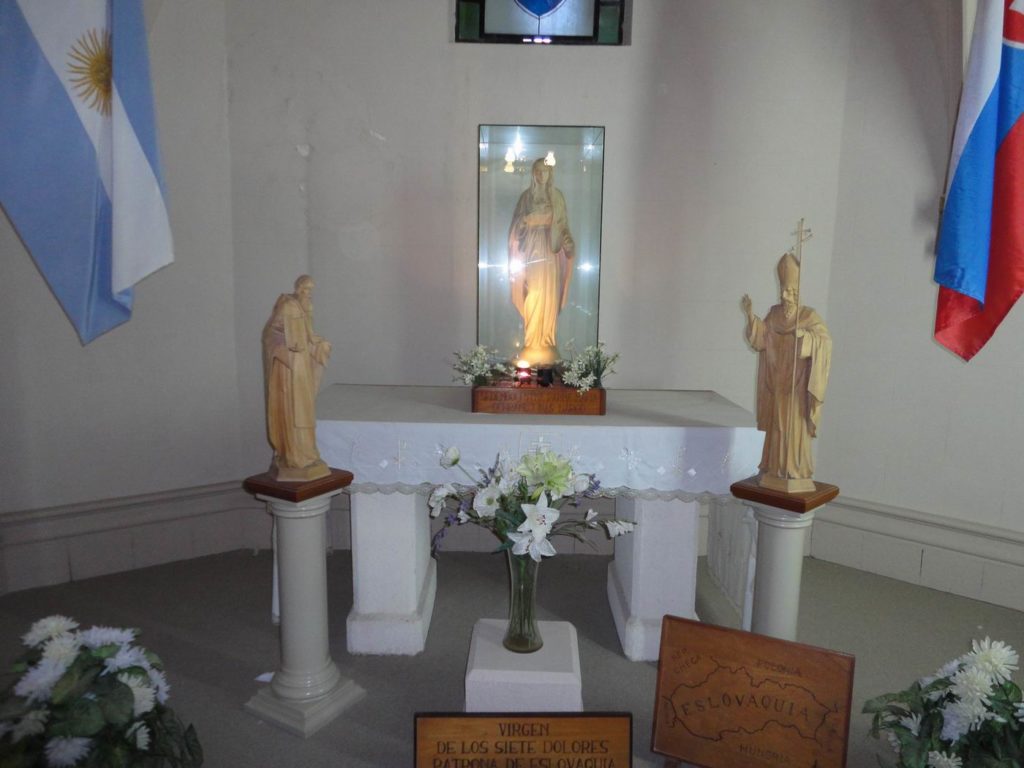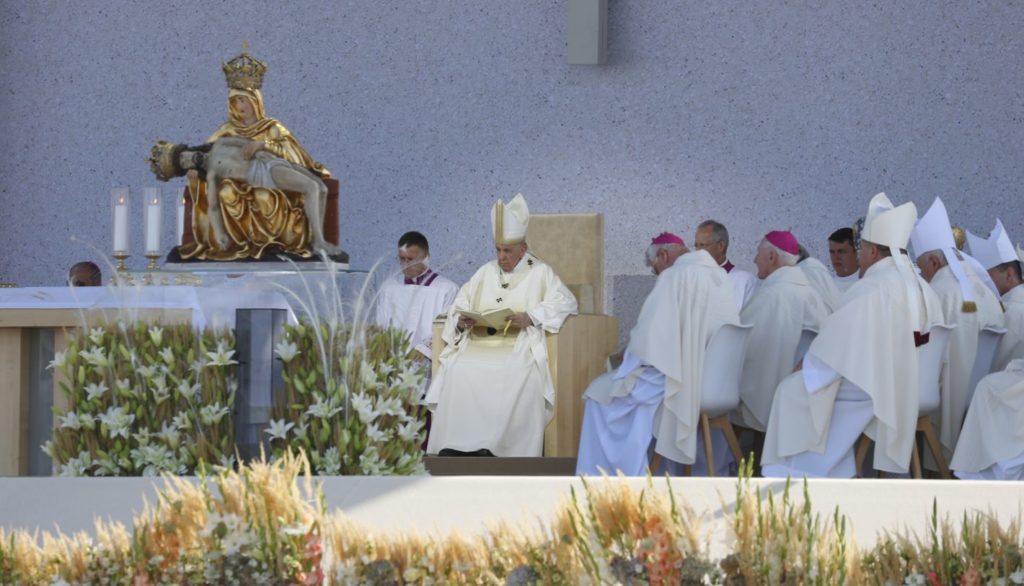The best for last. Today, Wednesday, September 15, is the day of the traditional national pilgrimage to the shrine of Šaštín, where the patroness of Slovakia, Our Lady of Seven Sorrows, is venerated. The particularity of this year's pilgrimage is that one of the pilgrims was Pope Francis himself. The Holy Father celebrated Holy Mass outdoors in the morning, after presiding over a prayer meeting with the bishops inside the shrine.
The city
Šaštín is a town with a long fame in the history of Slovakia. Its history dates back to the arrival of Saints Cyril and Methodius in the ancient homeland of the Slovaks. It was an important fortress for the protection of trade routes at the crossroads of the Danube, Bohemian and Znojmo roads. The name of the castle and the settlement comes from the words "Šášie" and "Tín", which means: castle of the cut trees. It was built by the Myjava River on a marshy ground. The castle was the seat of the county and archdeaconry governors, representatives of the bishop. The archdeaconry of Šaštín administered the deacons from Moravský Ján to Čachtice. Thus, Šaštín was always the seat of the dean and archdeacon, who resided in the castle. The first church, the castle chapel, was probably located there. The first written mention is from 1204, when Imrich II gave the Győr family a property called "Sassin". Later, the property was acquired by Imrich Czobor I. His son Imrich Czobor II settled here permanently.
The pilgrimage
The tradition of pilgrimage to Šaštín is closely linked to Marian veneration. Angelika Bakičová, the wife of Count Imrich Czobor, used to pray for her husband before an image of the Virgin Mary that hung from a tree near the castle. In gratitude for his conversion, she had an image of Our Lady of the Seven Sorrows made in 1564. The people greatly venerated this Virgin and prayed to the new image to heal their body and soul. After examining 726 miraculous cases, the statue was declared miraculous in 1732 by an investigative commission established by the bishop of Esztergom. In 1762, the statue was solemnly moved to the main altar of the Basilica. Empress Maria Theresa participated in the ceremony as a supporter of the construction of the basilica itself. In 1927, Pope Pius XI proclaimed Our Lady of the Seven Sorrows as the patron saint of Slovakia.
The Basilica
In 1733, the Pauline Order (Order of St. Paul, first hermit) arrived in Šaštín and undertook to build a pilgrimage church and monastery. Construction began in 1736 with the blessing of the foundation stone. In 1748 the building and the roof of the church part were completed, and three years later the monastery was also covered. In 1786, the Pauline monastery was suppressed by order of Emperor Joseph II, and the monks left for Poland. Both the church and the monastery came under the administration of diocesan priests.
From 1924, the Salesian Order was present in Šaštín, and was active until 1950, when it was forcibly expelled. In 1964, Pope Paul VI elevated the Shrine of the Virgin Mary of the Seven Sorrows to the status of a Minor Basilica. The Salesians returned to Šaštín for a brief period in 1968-1970 and then for a longer period after the change of political regime in 1990. At the monastery they ran a Catholic high school (gymnázium) for boys until 2016. In 2017, the Salesians were replaced again by the original administrators: the Paulines.
At the present time
The most significant visits of modern pilgrims were those of Mother Teresa of Calcutta (1987) and the Holy Father St. John Paul II, who prayed in the Basilica during his second pastoral visit to Slovakia (1995). Currently, Šaštín hosts every year about 200 national and 40 foreign pilgrimages (besides believers from neighboring countries, those from Spain and Mexico are no exception). In total, there are about 200,000 pilgrims a year, of which about 40,000 come during the main national pilgrimage. The feast of Our Lady of Seven Sorrows on September 15 is also a national holiday in Slovakia.
In addition to the national pilgrimage and the pilgrimage of Greek Catholics, thematic pilgrimages are traditional in Šaštín: the pilgrimage of lovers, the pilgrimage of men, the pilgrimage of mothers, the pilgrimage of ministers, the pilgrimage of motorcyclists, the pilgrimage of broken hearts and others.
Francis in Šaštín
During his homily, the Pope insisted on not reducing the Christian life: "Let us not forget this: faith cannot be reduced to a sugar that sweetens life. It cannot be. Jesus is a sign of contradiction. He came to bring light where there is darkness, bringing the darkness to the light and forcing it to surrender. That is why darkness always fights against Him. Whoever accepts Christ and opens himself to him rises; whoever rejects him closes himself in darkness and is ruined."
More than 50,000 people came to Šaštín to celebrate the Solemnity of Our Lady of the Seven Sorrows, patroness of Slovakia, at the Holy Mass with Pope Francis today. It was the crowning moment, which the Pope presided over at the end of a very important four-day pastoral journey in Slovakia. After the Mass, the farewell ceremony will take place at the airport and he will fly to Rome.
A connection between Slovakia and Argentina
On this last day of the Holy Father's visit to Slovakia, there will be a spiritual arc between Slovakia and Argentina: the Eucharistic celebration for the Patron Saint of Slovakia, Our Lady of the Seven Sorrows at the National Shrine in the Basilica of the Virgin of Luján in Argentina, the home country of Pope Francis. This initiative has been promoted by the Ambassador of Slovakia in Argentina, H. E. Rastislav Hindický; and the Mass will be celebrated by Father Lucas García, Rector of the Basilica of Luján.

The celebration will take place at 11.00 a.m. on the same day that Pope Francis is celebrating Mass at the National Shrine of Slovakia in the Basilica of Šaštín. The Mass will be followed by a speech by the Ambassador of Slovakia, who will also offer the floral offering in the colors of Slovakia to the image of Our Lady of the Seven Sorrows on display in the Crypt of the Basilica. The image of the Patron Saint of Slovakia is in her chapel in the crypt of the Basilica of Lujan, where it was inaugurated in November 1996, 25 years ago.









